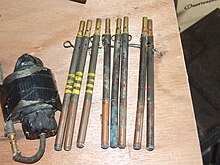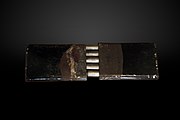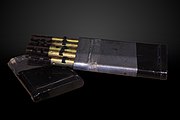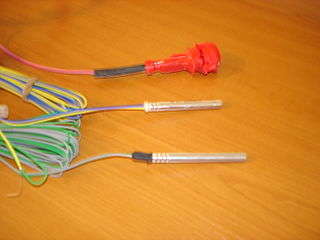
A detonator is a device used to make an explosive or explosive device explode. Detonators come in a variety of types, depending on how they are initiated and details of their inner working, which often involve several stages. Types of detonators include non-electric and electric. Non-electric detonators are typically stab or pyrotechnic while electric are typically "hot wire", exploding bridge wire or explosive foil.

In an explosive, pyrotechnic device, or military munition, a fuse is the part of the device that initiates function. In common usage, the word fuse is used indiscriminately. However, when being specific, the term fuse describes a simple pyrotechnic initiating device, like the cord on a firecracker whereas the term fuze is used when referring to a more sophisticated ignition device incorporating mechanical and/or electronic components, such as a proximity fuze for an M107 artillery shell, magnetic or acoustic fuze on a sea mine, spring-loaded grenade fuze, pencil detonator, or anti-handling device.
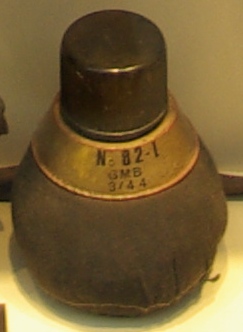
The Gammon bomb, officially known as the No. 82 grenade was a British hand grenade used during World War II.
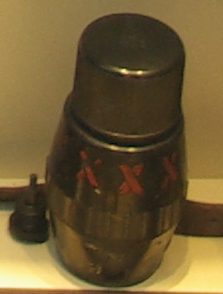
The British No. 69 was a hand grenade developed and used during the Second World War. It was adopted into service due to the need for a grenade with smaller destructive radius than the No. 36M "Mills bomb". This allowed the thrower to use a grenade even when there was little in the way of defensive cover. In contrast, the much greater destructive radius of the Mills bomb than its throwing range forced users to choose their throwing point carefully, in order to ensure that they would not be wounded by the shrapnel explosion of their own grenade.
The Lewes bomb was a blast-incendiary field expedient explosive device, manufactured by mixing diesel oil and Nobel 808 plastic explosive. It was created by Lieutenant Jock Lewes, one of the original members of L Detachment SAS in 1941.
The military of the United States has used many different types of hand grenades since its foundation.

The PMN series of blast anti-personnel mines were designed and manufactured in the Soviet Union. They are one of the most widely used and commonly found devices during demining operations. They are sometimes nicknamed "black widow" because of their dark casings.

An anti-handling device is an attachment to or an integral part of a landmine or other munition such as some fuze types found in general-purpose air-dropped bombs, cluster bombs and sea mines. It is designed to prevent tampering or disabling, or to target bomb disposal personnel. When the protected device is disturbed, it detonates, killing or injuring anyone within the blast area. There is a strong functional overlap of booby traps and anti-handling devices.

The SC 250 was an air-dropped general purpose high-explosive bomb built by Germany during World War II and used extensively during that period. It could be carried by almost all German bomber aircraft, and was used to notable effect by the Junkers Ju 87 Stuka. The bomb's weight was about 250 kg, from which its designation was derived.

The HG 85 is a round fragmentation hand grenade designed for the Swiss Armed Forces, and is still produced by RUAG Ammotec in Switzerland. HG 85 is the internal designation of the Swiss Army and replaced the HG 43 from World War II.

A tilt fuze or fuse is a device usually used in the operation of car bombs and other such detonators, relying on the force of a jerk or similar movement for the triggering of the desired explosion.
In military munitions, a fuze is the part of the device that initiates its function. In some applications, such as torpedoes, a fuze may be identified by function as the exploder. The relative complexity of even the earliest fuze designs can be seen in cutaway diagrams.

A grenade is an explosive weapon typically thrown by hand, but can also refer to a shell shot from the muzzle of a rifle or a grenade launcher. A modern hand grenade generally consists of an explosive charge ("filler"), a detonator mechanism, an internal striker to trigger the detonator, an arming safety secured by a transport safety. The user removes the transport safety before throwing, and once the grenade leaves the hand the arming safety gets released, allowing the striker to trigger a primer that ignites a fuze, which burns down to the detonator and explodes the main charge.
Ministry of Defence 1 (MD1), also known as "Churchill's Toyshop", was a British weapon research and development organisation of the Second World War.

An artillery fuze or fuse is the type of munition fuze used with artillery munitions, typically projectiles fired by guns, howitzers and mortars. A fuze is a device that initiates an explosive function in a munition, most commonly causing it to detonate or release its contents, when its activation conditions are met. This action typically occurs a preset time after firing, or on physical contact with or detected proximity to the ground, a structure or other target. Fuze, a variant of fuse, is the official NATO spelling.
A contact fuze, impact fuze, percussion fuze or direct-action (D.A.) fuze (UK) is the fuze that is placed in the nose of a bomb or shell so that it will detonate on contact with a hard surface.

The number 106 fuze was the first British instantaneous percussion artillery fuze, first tested in action in late 1916 and deployed in volume in early 1917.
The Type 3 81 mm mortar is a smooth bore, muzzle-loading 81 mm (3.19 in) infantry weapon used by the Imperial Japanese Army during World War II. The Type 3 designation was given to this gun as it was accepted in the 3rd year of Emperor Taishō's reign (1914).
The Frangible Grenade M1 was a specially designed factory produced molotov cocktail created by the United States in 1942 as it entered World War II (1939–1945). It was designed to provide lightly armed personnel with simple, uncomplicated weapons that were easy to mass-produce. It provided a cheap stopgap means of knocking out enemy vehicles, clearing out strongpoints, and harassing or killing enemy personnel until more effective weapons could be produced and distributed. It was dubbed "frangible" because it was made from glass, which is brittle and easily broken.

The AB 250-2(Abwurfbehälter) was a cluster bomb used by the Luftwaffe during World War II.
